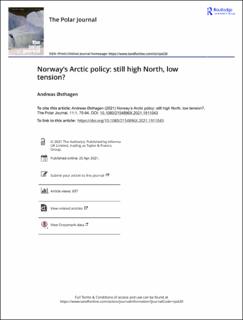| dc.contributor.author | Østhagen, Andreas | |
| dc.date.accessioned | 2021-07-28T07:21:32Z | |
| dc.date.available | 2021-07-28T07:21:32Z | |
| dc.date.created | 2021-04-26T09:39:04Z | |
| dc.date.issued | 2021 | |
| dc.identifier.issn | 2154-896X | |
| dc.identifier.uri | https://hdl.handle.net/11250/2765451 | |
| dc.description.abstract | For Norway, the Arctic is an integral part of the country in terms of both economic development and security considerations. Since 2005, consecutive governments in Oslo have made use of this fact, in combination with international attention given to the north, to foster a High North policy framed around regional economic development, climate issues and international cooperation (especially vis-à-vis Russia). However, over the last few years, challenges have emerged. Focusing on the foreign and security policy aspects of Norway’s Arctic approach, this article defines Norway’s Northern engagement and how this engagement has evolved since 2005. Then, the challenges currently facing Norway in the domain of foreign and security policy are discussed in terms of the new Arctic policy document released in late-2020. These challenges are broadly surmised as relating to Russia’s military posture and the use of the Arctic as an arena for a China–US tug of war. | |
| dc.language.iso | eng | |
| dc.relation.uri | https://wo.cristin.no/as/WebObjects/cristin.woa/wo/26.0.29.25.8#anker | |
| dc.title | Norway’s arctic policy: still high North, low tension? | |
| dc.type | Peer reviewed | |
| dc.type | Journal article | |
| dc.description.version | publishedVersion | |
| dc.source.volume | 11 | |
| dc.source.journal | The Polar Journal | |
| dc.source.issue | 1 | |
| dc.identifier.doi | 10.1080/2154896X.2021.1911043 | |
| dc.identifier.cristin | 1906336 | |
| dc.relation.project | Fridtjof Nansens institutt: 485 | |
| dc.relation.project | Norges forskningsråd: 302176 | |
| dc.relation.project | Fridtjof Nansens institutt: 486 | |
| dc.relation.project | Norges forskningsråd: 302343 | |
| cristin.ispublished | true | |
| cristin.fulltext | original | |
| cristin.qualitycode | 1 | |
